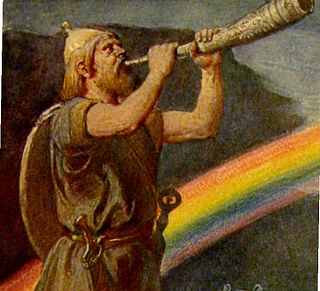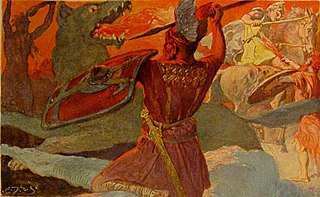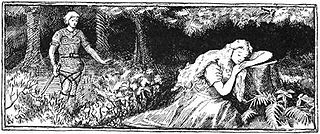
In Norse mythology, Bifröst is a burning rainbow bridge that reaches between Midgard (Earth) and Asgard, the realm of the gods. The bridge is attested as Bilröst in the Poetic Edda; compiled in the 13th century from earlier traditional sources, and as Bifröst in the Prose Edda; written in the 13th century by Snorri Sturluson, and in the poetry of skalds. Both the Poetic Edda and the Prose Edda alternately refer to the bridge as Ásbrú.
"Edda" is an Old Norse term that has been attributed by modern scholars to the collective of two Medieval Icelandic literary works: what is now known as the Prose Edda and an older collection of poems without an original title now known as the Poetic Edda. The term historically referred only to the Prose Edda, but this since has fallen out of use because of the confusion with the other work. Both works were written down in Iceland during the 13th century in Icelandic, although they contain material from earlier traditional sources, reaching into the Viking Age. The books are the main sources of medieval skaldic tradition in Iceland and Norse mythology.
In Norse mythology, Hvergelmir is a major spring. Hvergelmir is attested in the Poetic Edda, compiled in the 13th century from earlier traditional sources, and the Prose Edda, written in the 13th century by Snorri Sturluson. In the Poetic Edda, Hvergelmir is mentioned in a single stanza, which details that it is the location where liquid from the antlers of the stag Eikþyrnir flow, and that the spring, "whence all waters rise", is the source of numerous rivers. The Prose Edda repeats this information and adds that the spring is located in Niflheim, that it is one of the three major springs at the primary roots of the cosmic tree Yggdrasil, and that within the spring are a vast amount of snakes and the dragon Níðhöggr.

Poetic Edda is the modern attribution for an unnamed collection of Old Norse anonymous poems, which is different from the Edda written by Snorri Sturluson. Several versions exist, all primarily of text from the Icelandic medieval manuscript known as the Codex Regius. The Codex Regius is arguably the most important extant source on Norse mythology and Germanic heroic legends. From the early 19th century onwards, it has had a powerful influence on later Scandinavian literatures. Not only by its stories, but also by the visionary force and the dramatic quality of many of the poems. It has also become an inspiring model for many later innovations in poetic meter, particularly in Nordic languages, offering many varied examples of terse, stress-based metrical schemes that lack any final rhyme by instead using alliterative devices and strongly-concentrated imagery. Poets who have acknowledged their debt to the Codex Regius include Vilhelm Ekelund, August Strindberg, J. R. R. Tolkien, Ezra Pound, Jorge Luis Borges, and Karin Boye.
The Prose Edda, also known as the Younger Edda, Snorri's Edda or, historically, simply as Edda, is an Old Norse work of literature written in Iceland during the early 13th century. The work is often assumed to have been written, or at least compiled, by the Icelandic scholar, lawspeaker, and historian Snorri Sturluson c. 1220. It is considered the fullest and most detailed source for modern knowledge of Germanic mythology.
In Norse mythology, Bestla is the mother of the gods Odin, Vili and Vé by way of Borr, the sister of an unnamed being who assisted Odin, and the daughter or, depending on source, granddaughter of the jötunn Bölþorn. Bestla is attested in the Poetic Edda, compiled in the 13th century from earlier traditional sources, the Prose Edda, written in the 13th century by Snorri Sturluson, and in the poetry of skalds. Scholars have commented on the obscurity of the figure's name and have proposed that she may be the wise being Mímir's sister.
In Norse mythology, Bölþorn or Bölþor is a jötunn, the father of Bestla, and therefore grandfather of the gods Odin, Vili and Vé. The figure receives mention in the Poetic Edda, composed in the 13th century from earlier traditional sources, and the Prose Edda, compiled by Icelander Snorri Sturluson in the 13th century. Scholars have noted that the Poetic Edda mention may mean that he is the father of the wise being Mímir.
In Norse mythology, Bergelmir is a Jötunn, the son of giant Þrúðgelmir and the grandson of Ymir, the first Jötunn, according to stanza 29 of the poem Vafthrudnismal from the Poetic Edda:

In Norse mythology, Vígríðr or Óskópnir is a large field foretold to host a battle between the forces of the gods and the forces of Surtr as part of the events of Ragnarök. The field is attested in the Poetic Edda, compiled in the 13th century from earlier traditional material, and in the Prose Edda, written by Snorri Sturluson in the 13th century. The Poetic Edda briefly mentions the field as where the two forces will battle, whereas the Prose Edda features a fuller account, foretelling that it is the location of the future death of several deities before the world is engulfed in flames and reborn.

In Norse mythology, a jötunn is a type of entity contrasted with gods and other figures, such as dwarfs and elves. The entities are themselves ambiguously defined, variously referred to by several other terms, including risi, thurs, and troll.
A hörgr or hearg was a type of altar or cult site, possibly consisting of a heap of stones, used in Norse religion, as opposed to a roofed hall used as a hof (temple).
A heiti is a synonym used in Old Norse poetry in place of the normal word for something. For instance, Old Norse poets might use jór "steed" instead of the prosaic hestr "horse".
In Norse mythology, Hræsvelgr is a giant who takes the form of an eagle.

In Norse mythology, Mímisbrunnr is a well associated with the being Mímir, located beneath the world tree Yggdrasil. Mímisbrunnr is attested in the Poetic Edda, compiled in the 13th century from earlier traditional sources, and the Prose Edda, written in the 13th century by Snorri Sturluson. The well is located beneath one of three roots of the world tree Yggdrasil, a root that passes into the land of the frost jötnar where the primordial plane of Ginnungagap once existed. In addition, the Prose Edda relates that the water of the well contains much wisdom, and that Odin sacrificed one of his eyes to the well in exchange for a drink.
In Norse mythology, Im or Imr is a giant and the son of Vafthrudnir. According to stanza 5 of the poem Vafthrudnismal from the Poetic Edda:
Chakato is a West Chadic language spoken in Plateau State, Nigeria. It was identified by Roger Blench in 2016. It is spoken by about 500 people in one village, Dokan Tofa, which is located on the Jos-Shendam road in Plateau State. Blench (2017) suggests that Chakato may be related to spurious records of the Jorto language. Chakato speakers claim that their language is closely related to Goemai.
In Norse mythology, the feminine Fjörgyn or Jörð is described as the mother of the thunder god Thor, son of Odin, and the masculine Fjörgynn is described as the father of the goddess Frigg, wife of Odin. Both names appear in the Poetic Edda, compiled in the 13th century from earlier traditional sources, and the Prose Edda, written in the 13th century by Snorri Sturluson. A number of theories surround the names, and they have been the subject of scholarly discourse.
In Norse mythology, Njörun is a goddess attested in the Prose Edda, written in the 13th century by Snorri Sturluson, and various kennings. Scholarly theories concerning her name and function in the pantheon include etymological connections to the Norse god Njörðr and the Roman goddess Nerio, and suggestions that she may represent the earth or be the unnamed sister-wife of Njörðr.

The second part of Snorri Sturluson's Prose Edda the Skáldskaparmál is effectively a dialogue between Ægir, the Norse god of the sea, and Bragi, the god of poetry, in which both Norse mythology and discourse on the nature of poetry are intertwined. The origin of a number of kennings is given; then Bragi delivers a systematic list of kennings for various people, places and things. He then goes on to discuss poetic language in some detail, in particular heiti, the concept of poetical words which are non-periphrastic, and again systematises these. This in a way forms an early form of poetic thesaurus.
Tófa (Tófu) is the wife of Angantyr and mother of Hervor in Norse mythology. She is mentioned only once the Poetic Edda, in Hervararkviða. The Poetic Edda is part of the Tyrfing Cycle of Old Norse legends.





